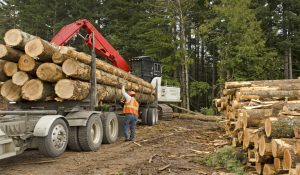Hiring a Logger in Minnesota for Deer Woods
Hiring a Logger in Minnesota for Deer Woods

Most of Minesotas forest land is owned by private landowners. Many of these landowners will only sell timber once or twice in their lifetime. Selling assets such as timber, homes, land, etc. should be done with a legal contract. Landowners should always use a solid written contract or timber deed when selling timber – as an added precaution it should be recorded at a courthouse. A well-executed contract or deed can avoid any misunderstandings between owners and buyers. A well-prepared contract describes the sell process and legal requirements. Hiring a professional forester is recommended as the development of a timber sale contract can intimidate most forest landowners. A professional forester will help guide the landowner through the timber sale process and ensure that all legal aspects of the contract are handled properly. Since timber sales typically generate a large income, most landowners should also seek the advice of an accountant and a lawyer during the process.
The following components are critical to include in all timber sale contracts whether the landowner uses a professional forester or not.
- Buyer and Seller
Who actually owns the timber? Will the buyer and seller use agents or deal directly with each other? If the seller is an absentee landowner, who will represent him/her? Can the buyer (re)assign rights? By clearly stating responsible parties in the timber sale contract, both the buyer and seller will be protected throughout the sale process.
- Length of the Contract
Clearly state the timber sale start and termination dates. State whether sale extensions will be allowed and cost calculation. An extension would certainly be a cost to the seller due to delayed regeneration. Which provisions will trigger a logging job shut down during bad weather? And who will make that call? Will the owner be notified when the operation begins, is temporarily ceased, and final closeout? This is extremely important for the seller especially with a per unit sale contract.
- Clearly State Sale Extent, Location & Legal Description
Clearly define what is being sold. Begin with a formal legal description, include a tract location map, with clearly marked property lines and sale boundaries. Improperly marked property lines or sale boundaries can lead to trespass and timber theft problems.
Define the types, sizes, and condition of the trees being sold. The buyer and seller should have a clear understanding of what is expected to be cut as well as what should not be cut. What units of measure will be used? Timber volume is measured in a variety of ways, and experienced foresters can provide the seller with a complete and detailed inventory of timber products on the property.
- Timber Price and Payment Schedule
Pricing timber can be tricky, and that is why you want a forester involved. Lump sum or per-unit sales will mean different types of payment schedules. A lump sum sale involves a negotiated price for an entire timber tract or sales area. The seller will receive the total payment before the timber is cut. In a per-unit sale the seller and buyer negotiate a price per unit of timber harvested. This type of sale results in the seller receiving payment as the timber is cut. Is there a down payment required? There are advantages and disadvantages to each of these methods of selling timber that the seller should be aware of. Who will make sure all the loads coming out the woods will be accounted for?
- Requiring a Performance Bond or Security Payment
-
Hiring a Logger in Minnesota for Deer Woods
Bonding or security payments ensure contract provisions are satisfied and that soil, water, and other resources are protected. All owners should mandate that adequate liability insurance is in place for all entities involved in the logging operation.
- Notification of Start/Start/Completion of Logging
Having an agreed upon time of notice in the contract for when the logging operation begins and ends can help the seller prepare for when the buyer is to be on the property. A notice of 24 to 48 hours should normally be given by the buyer when the operation begins and when it ends. If the sale is “pay as cut”, having this advanced notice can also help the seller to keep up with load numbers, dates, and inspections of the operations.
- Maintenance and Condition of Access Roads and Log Decks
The seller should clearly state the conditions of access in the contract. Roads should be kept maintained during the logging and restored to their former condition at the buyer’s expense upon the completion of the operation. Require a pre-harvest plan that delineates log decks and skid trail locations. The timber sale contract should require that all deck and skid trail locations be approved by the seller or their agent prior to the start of the operation.
- Require Best Management Practices
A harvest map is a must in a proper timber sale. A Map details tract and sale boundaries, location of landings, stream crossings, logging roads, and any environmentally sensitive areas like wetlands or special wildlife habitats. Adherence to Best Management Practices will ensure proper disposal of trash, fluids logging slash and debris; contract specifications address these issues thoroughly.
Always include a “Right to Halt Logging” provision in the contract with provisions to extend the contract length if operations are halted due to wet conditions that would damage the soil.
- Removal of Trees Outside the Sale Area
Penalties need to be clearly specified in the contract. Timber trespass, while usually not intentional, occurs occasionally and needs to be addressed in the contract. Holding the buyer accountable within the contract can help the seller to avoid this situation.
- Fire and Other Disaster Provisions
The buyer should be required to follow all fire laws. Clearly specify who assumes the liability from fire and other natural disasters during the length of contract. A sound contract covers all contingencies should a legal depute arise during the length of the contract.
- Arbitration and Contract Disagreements
When disagreements about contract provisions arise, most contracts specify an arbitration mechanism that avoids the courts and a legal solution. This process involves a neutral third party to settle the dispute after both sides have had an opportunity to be heard. Having a professional forester involved in the sale process can be beneficial in this situation to help facilitate the arbitration process.
- Indemnity, Insurance, and Safety Regulations
It is prudent for the seller to ensure that liability for logging operations rest solely with the buyer/loggers. Responsibility for liability and worker’s compensation insurance also rests with the buyer and logger. Adherence to all state and federal safety and health requirements during the logging operation must clearly be stated in the sales contract.
The timber sale contract is an important legal document and should be reviewed by your attorney. The items detailed in the list above are not exhaustive and may not cover every timber sale situation. A sample timber sale contract has been included with this publication as a guide for landowners. However, it is important for the landowner to seek professional assistance from consulting foresters, attorneys, and accountants to ensure that each step of the process is done correctly.
Summary
Timber sale contracts should be clear, concise, and legally defensible. A contract is only as good as it is written. Landowners should be certain that when selling timber all contingencies are address so that the experience will be positive and profitable. In most cases, the seller will be at a disadvantage when negotiating a contract with a timber buyer or logger. The issues presented in this document can help the landowner to avoid certain pitfalls when selling timber. Every timber tract and sale is unique. Hire a professional forester to plan and execute a timber sale is a sound investment.
A consultant offers this advice to experienced landowners selling timber:
- Know what you are selling! Always have an inventory (cruise) before talking to timber buyers.
- Know the product specifications.
- Require a high advance deposit.
- Require a high performance bond.
- Use motion detector cameras with infrared cameras (hunting cameras that can be locked with a cable).
- Require a load sheet with each settlement – watch a truck leave, then check to make sure they wrote down the correct information.
- Require a copy of all scale tickets with each settlement.
- Conduct a pre-harvest conference with the buyer, logger, and owner. Make sure the buyer and logger know you are checking on them.
- Spot check the loader – watch them load each product – you have to know the product specifications.
- Talk to the loader operator he is the one who makes or breaks product merchandising going on the truck.
- Use a blend (one price for CNS/Sawtimber) – this eliminates poor merchandising issues on sawtimber products.
-
Hiring a Logger in Minnesota for Deer Woods

